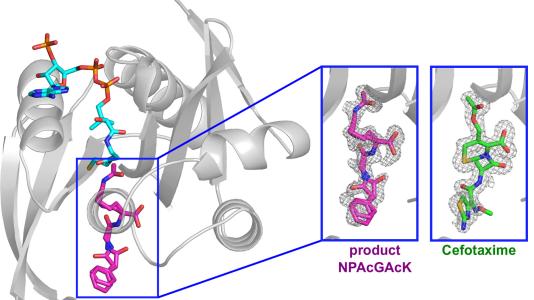
They determined the 3-D structure and likely function of a new protein in this common bacterium that attacks those with compromised immune systems.
The international team of scientists led by Wayne Anderson of Northwestern University and Wladek Minor of the University of Virginia also found a potential way to slow the bacteria’s growth. Using the U.S. Department of Energy’s Advanced Photon Source at Argonne National Laboratory, they determined that the antibiotic cephalosporin inhibits the new protein’s performance and potentially could be used to develop an effective treatment.
The bacterium, called Pseudomonas aeruginosa, is widely distributed in soil, water, skin and most man-made environments throughout the world, including hospitals. It is a versatile survival expert, tolerating diverse surroundings, low-oxygen conditions and a wide variety of food sources. Because patients with weak immune systems are more susceptible to infection, this bacterium is frequently responsible for infections acquired while in hospitals — especially susceptible are burn victims and cystic fibrosis patients.
Using X-ray technology, scientists determined the detailed three-dimensional structure and molecular function of this important protein. This effort puts a face to the name of a protein previously known only by its DNA sequence. While valuable information, the DNA sequence alone is not enough to find out what a protein can do. In order to determine the function, a precise 3-D model of the protein is needed.
To characterize the new protein, known as PA4794, Karolina Majorek, Misty Kuhn and Maksymlian Chruszcz, led by Professors Anderson and Minor, analyzed enormous amounts of data. Their collaboration involved the University of Virginia, Adam Mickiewicz University in Poland, Northwestern University and the University of South Carolina, as well as the Center for Structural Genomics of Infectious Diseases and the Midwest Center of Structural Genomics, both based at Argonne. The work “Structural, functional and inhibition studies of GNAT superfamily protein PA4794: a new C-terminal lysine protein acetyltransferase form Pseudomonas aeruginosa” was published in the Journal of Biological Chemistry.
The new protein lies within some of the least explored territory in biology, inside an enormous and poorly understood superfamily of enzymes. This particular group of proteins, called the GNAT family, is found in animals, plants and bacteria. GNATs play a role in small molecule and protein acetylation, which is an important force in defining and changing the function of proteins. Proteins perform a vast array of tasks including catalyzing metabolic reactions, replicating DNA, transporting molecules from one place to another and responding to stimuli. Understanding protein structure and function is crucial for unraveling how these processes work and for discovering new drugs to control or affect these processes.
The APS facility, where the protein was described, is used by thousands of scientists worldwide. The current study used multiple beamlines run by two collaborative access teams at the APS: the Life Science-CAT and the Structural Biology Center. This large synchrotron facility has 63 beamlines available for use, each optimized for a particular field of research.
Minor said this work was “pushing beamlines to the limit of the experimental envelope.” The beamlines at the APS are “the best in the world” for this type of discovery, he added, as they give the highest resolution to distinguish minute features. “Obtaining high-quality structures,” he explained, “is essential to being able to determine protein function, as the function depends on very small details.”
The starting point of these studies is the preparation of suitable crystals of potential complexes of the protein, each bound to hundreds of chemical compounds called “ligands.” Majorek and team analyzed several hundred datasets and screened more than 600 tiny protein crystals using a method called X-ray crystallography. Obtaining this type of data will become faster and easier in the future. When the Advanced Protein Crystallization Facility opens adjacent to the APS, we will be able to “get results on the fly, quickly redesign and re-planning experiments,” Minor said. The future of protein discovery and the X-ray beamlines of the APS will both be brighter.
Use of the APS is funded by the DOE’s Office of Science. The research was funded by NIAID and GM.
The Advanced Photon Source at Argonne National Laboratory is one of five national synchrotron radiation light sources supported by the U.S. Department of Energy’s Office of Science to carry out applied and basic research to understand, predict, and ultimately control matter and energy at the electronic, atomic, and molecular levels, provide the foundations for new energy technologies, and support DOE missions in energy, environment, and national security. To learn more about the Office of Science X-ray user facilities, visit the user facilities directory.
Argonne National Laboratory seeks solutions to pressing national problems in science and technology. The nation’s first national laboratory, Argonne conducts leading-edge basic and applied scientific research in virtually every scientific discipline. Argonne researchers work closely with researchers from hundreds of companies, universities, and federal, state and municipal agencies to help them solve their specific problems, advance America’s scientific leadership and prepare the nation for a better future. With employees from more than 60 nations, Argonne is managed by UChicago Argonne, LLC for the U.S. Department of Energy’s Office of Science.
DOE’s Office of Science is the single largest supporter of basic research in the physical sciences in the United States, and is working to address some of the most pressing challenges of our time. For more information, please visit science.energy.gov.
DID YOU KNOW?
More than 5,500 researchers per year conduct experiments at the Advanced Photon Source.